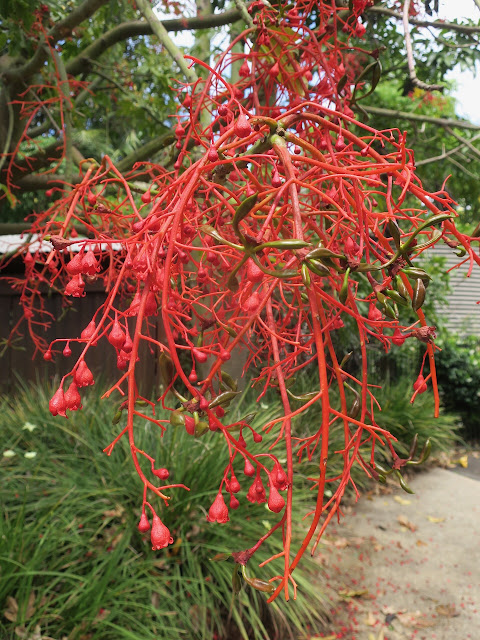In the week before Christmas I had a brief walk along the Barwon River at Newtown as I was early for an appointment.
There was a light drizzling rain when I came across this patch of waterlilies, that I thought looked quite beautiful. A calming moment before seeing the dentist.
Last weekend we went to Melbourne for Christmas and had the luxury of a slow walk around the Royal Botanic Gardens.
There I saw more water lilies. Almost the whole surface of one of the upper lakes was covered in pink waterlilies.
This individual flower near the water's edge looked particularly beautiful.
As did this mass of pink, mauve and purple Hydrangeas.
There was a whole bed of this dark blue Agapanthus. One of the cultivars that has appeared in recent years.
Summer is the flowering time for one of my favourite native trees, the Illawara Flame Tree Brachychiton acerifolius. In Victoria, if the conditions are right, it will loose all of its leaves before the spectacular flowering.
This close up of a panicle reveals part of the reason the flowering is so dramatic. The stems of the flowers are also the same intensely bright red. This panicle was on a tree in the Ian Potter Foundation Children's Garden at the Botanical Garden.
Which is where we also came across this tree where something small may live.
Over the past couple of months in the Botanic gardens I have noticed an unusual event. In a number of places around the garden some clumps of bamboo have started flowering. Bamboos flower infrequently, usually after 40 - 80 years. However, some species only flower after very long intervals, as much as 120 -130 years.
In this photo it is easy to see that the flowers look like those of other grasses.
In this photo most of the bamboo has already turned brown and is dying. It is a mass flowering event in which all the plants in the cohort will flower and then decline and die. Seeds that fall from these plants will start the regrowth of the patch. * * * * *
Recently I re-introduced our Tree Philodendron Thaumatophyllum bipinnatifidum to the conservatory. The unfortunate, but very resilient, plant had spent the better part of two years out in the garden suffering considerable neglect. Finally, three or four months ago, I re-potted the plant and started to treat it more respectfully in the conservatory. It has responded well to the warmth, watering and feeding, by producing some larger leaves and two smaller shoots at the bottom.
One of the leaves recently yellowed and began to die (of old age) first turning a beautiful bright yellow. This made it an interesting, somewhat largish, ikebana subject.
Because of a noticeable curve in its stem I decided to use this large curving vessel by Graeme Wilkie. The yellow leaf is the main subject but needed a foil. Green seemed best to highlight the yellow. I chose a fading leaf from the Strelitzia nicolai that had some autumnal tonings and a similar curve. With such strong materials, nothing else was needed.
I would like to wish you all a healthy and Happy New Year.
Greetings from Christopher
31st December 2023





.jpeg)







.jpeg)

.jpeg)
.jpeg)

.jpeg)




.jpeg)
.jpeg)
.jpeg)
.jpeg)
.jpeg)
.jpeg)
.jpeg)




